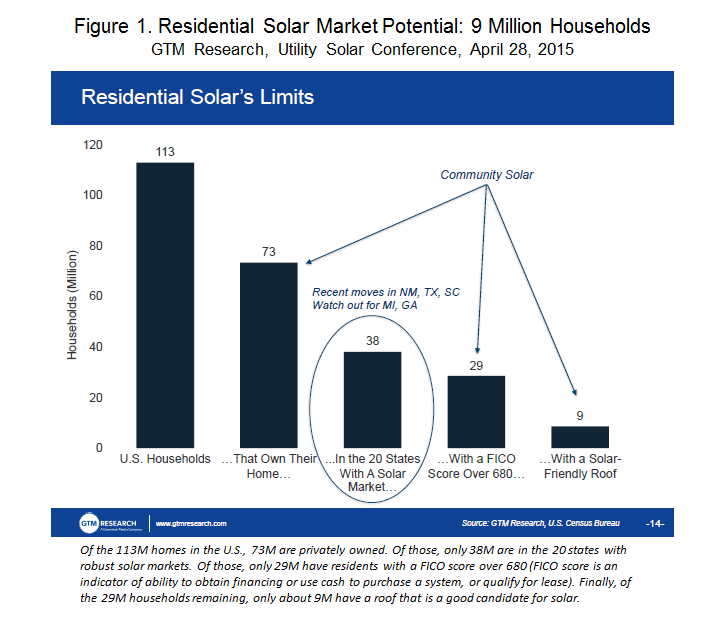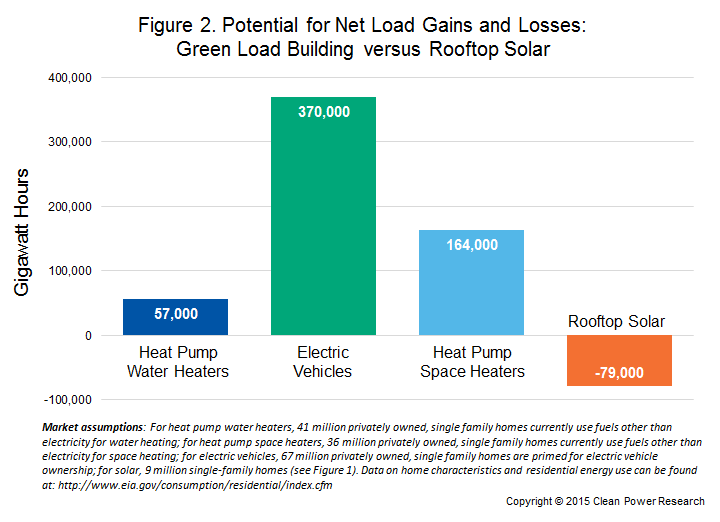For all the talk of utility death spirals, a single graph from GTM Research’s Shayle Kann, presented at the recent Solar Electric Power Association’s (SEPA) annual Utility Solar Conference (USC), should give U.S. utilities significant comfort that residential solar isn’t going to bring about their downfall. The graph in Figure 1, which summarizes the total potential U.S. market for residential solar, explains why.
Of the 113 million households in the U.S., Kann estimates that only 9 million or so homes have a roof that is a good candidate for solar. Kann’s analysis is rough, but even if you assume that twice that number of homes are good candidates for rooftop solar (i.e., approximately 18 million), that is still less than 20% of all U.S. households. Even if they all go solar, that hardly portends a death spiral.

Enough about threats. What about the opportunities? When utilities get prices right (for more on getting electric rates right, see the first article in the series “Lessons from SEPA’s Utility Solar Conference”), two opportunities in particular stand out: community solar and green load building.
Community solar
At this year’s USC event, community solar was the single most talked about topic. Every utility in attendance was in some stage of planning a community solar offering for their customers. While no two utility community solar programs are alike, there are many consistencies:
- Most utilities are planning to own the solar assets and make a return on the investment, much like their traditional business.
- Utilities are generally aiming to offer their community solar customers a return on their investment or a cash flow that is more attractive than rooftop solar, or buying electricity conventionally.
- Finally, utilities are seeking to offer their customers something they are demanding—choice!
It will be interesting to see how community solar develops over the next several years as programs evolve, but it will likely be one of the fastest growing segments of the U.S. solar industry. Of course, critical to the success of community solar is getting rates right. If rates are inefficiently set, consumers will not have the proper incentives to make economically efficient decisions to invest in community solar.
Community solar is one of the single largest opportunities for utilities to grow revenue. Community solar can be offered to the 80+% of households that rooftop solar may not be right for. Further, solar has very low operation and maintenance costs, low fuel costs and high asset costs. This combination means that the utility can maximize both revenue and assets in its regulated asset base.
Building “green loads”
As big as the community solar opportunity is, green load building may be even bigger. Green load building involves utilities incenting their customers to adopt flexible loads that use clean energy (a.k.a., electricity) rather than “dirty” fuels (i.e., natural gas and petroleum products). The biggest opportunities for green-load building are electric vehicles, heat pump water heaters and heat pump space conditioning.
All three of these loads have some flexibility: An EV typically only needs to charge for 4-8 hours a day, and heat pump water heaters and space conditioners can shift their loads by making small temperature adjustments. With the right price signals in the form of better rate design, electric consumers will have the right incentives to invest in technologies that use more electricity (increase loads), but reduce carbon pollution. Green load building has four major advantages:
- Flexible green loads can be shifted to off-peak times with proper price signals, thereby “filling the belly of the duck.”
- These technologies all offer significant opportunities to reduce pollution, particularly carbon pollution, as the utility generation mix shifts to cleaner technologies.
- With the proper price signals, flexible green loads can flatten the load curve, allowing utilities to charge lower rates, but get a higher rate of return on their invested capital through higher capacity utilization.
- Increasing total load helps reverse the trend of declining load that many utilities face, and provides additional revenue growth opportunities.
Green load building is not only win-win-win-win, but it’s a huge opportunity for utilities. The graph below illustrates the relative potential for net load gains and losses from green load building (i.e., heat pump water heaters, space conditioners and electric vehicles) and rooftop solar. The opportunities clearly dwarf the load-loss risk of rooftop solar.

A world of opportunities
We are living through the most exciting decade of change that the electric utility industry has faced in a century. The utility model is changing, but it is not dying. On the contrary, opportunities abound to offer customers greater choice while simultaneously growing the utility asset base, increasing revenue and reducing pollution.
From community solar to electric vehicles, heat pump water heaters and HVAC, the opportunities are there for utilities and regulators that get rates right, provide proper incentives and have a vision for the customer-centered utility of the future.
